This was published 4 years ago
World's oldest airports: Sydney Airport celebrates 100 years in 2019
By Steve Meacham
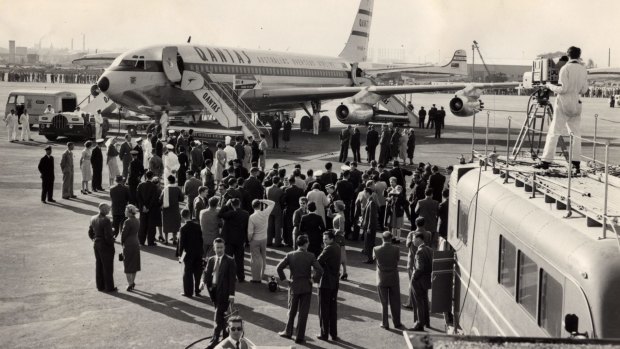
Delivery of the first Boeing 707 to Sydney Airport, 2 July 1959.Credit: Courtesy of the Qantas Heritage Collection
Pioneer aviator Nigel Love - who learned to fly over the trenches of World War I - pulled back on the joystick of his two-seater Avro 504K biplane and took off from a former cow paddock on the northern shore of Botany Bay, the airfield for his new aviation business.
That was 100 years ago, on November 19, 1919.
His paying passenger, Billy Marshall, was another innovator: a movie cameraman wanting to take the first aerial images of Australia. Marshall's first flight didn't go well, however, he was so disoriented his film was out of focus.
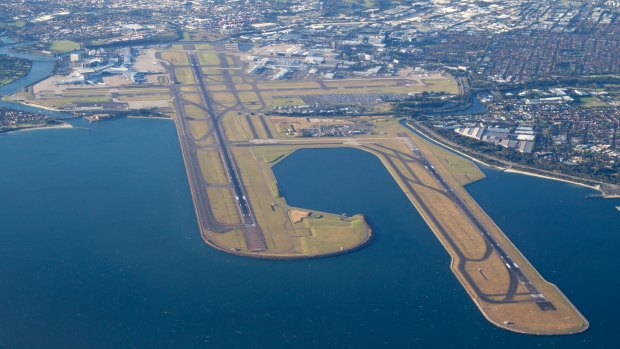
Aerial view of Sydney Airport.Credit: Seth Jaworski
That inauspicious flight - which took place just 16 years after Orville and Wilbur Wright flew their powered glider over Kitty Hawk beach in North Carolina - is being celebrated this month as Sydney Airport marks its centenary and claims its place as one of the 10 oldest continuously-operating commercial airports in the world.
That can't be true, surely? What about Heathrow, JFK, Charles de Gaulle, Changi, Chicago, LAX? Turns out, they're all Johnny-come-latelies.
Fittingly, Sydney airport welcomed its billionth passenger in September: 10-year-old Katinka Hermens, who arrived home on a Singapore Airlines Airbus 380 with her mother and younger brother. The whole family had been upgraded to business class.
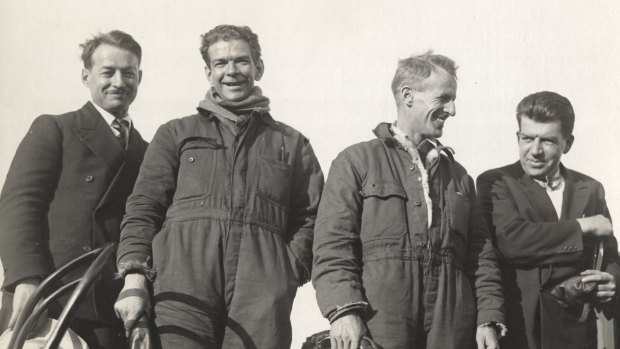
Crew of the Southern Cross, the first flight to Australia across the Pacific Ocean, was met by great crowds when it landed at Mascot Aerodrome on 10 June 1928 .L-R James Warner, Charles Ulm, Charles Kingsford Smith and Harry Lyon.Credit: Courtesy of the Aviation Historical Society of Australia (NSW)
Each year, Sydney Airport handles 44 million passengersand the airport's chief executive, Geoff Culbert, predicts it will welcome its two billionth passenger by 2040.
The estimate is complicated by a new kid on the block: Sydney's long-awaited second airport, which is due to open in 2026 at Badgerys Creek in Western Sydney. It is provisionally named after Australia's most famous female aviator, Nancy Bird Walton.
Between Billy Marshall's first flight (he got the images he was looking for on subsequent adventures in Love's biplane) and Hermen's upgrade to business class, both Australia and aviation have changed irrevocably.
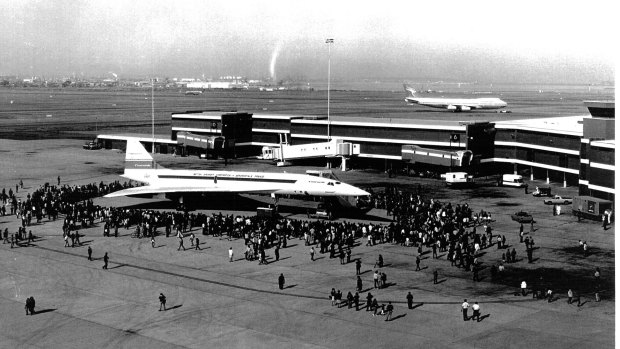
Concorde made its first visit to Sydney Airport on 20 June 1972 With a maximum speed of 2,179km/h, more than twice the speed of sound.Credit: Courtesy of the Civil Aviation Historical Society
Love wouldn't recognise it today.
Though Sydney airport is now named after Sir Charles Kingsford Smith, the nation's most famous aviator, it could just as easily have been named after its founder. And wouldn't that have been a marketing coup, with cabin crew able to announce on touchdown: "Welcome to Love."
As Love wrote himself, he and his Australian business partner had negotiated the purchase of 20 Avro biplanes in Manchester before searching for a suitable airfield in Sydney.
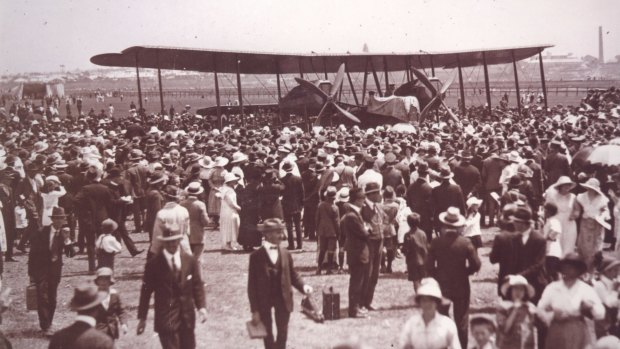
The Smith brothers' Vickers Vimy biplane greeted by a crowd at Mascot Aerodrome, 14 February 1920.Credit: Courtesy of Bayside Libraries (Community History Collection)
"I spent some time in a car examining likely areas on the outskirts of Sydney." Then a real estate agent rang asking if he'd seen "the bullock paddock at Mascot", owned by Kensington Racing Club.
It was perfect, Love decided. Flat and covered in buffalo grass grazed by sheep and cattle, the 140 acre site "needed no money spent to make it serviceable for aircraft" and had "virtually no obstructions" on any of its four sides.
He leased the land, and waited for his Avros to arrive.
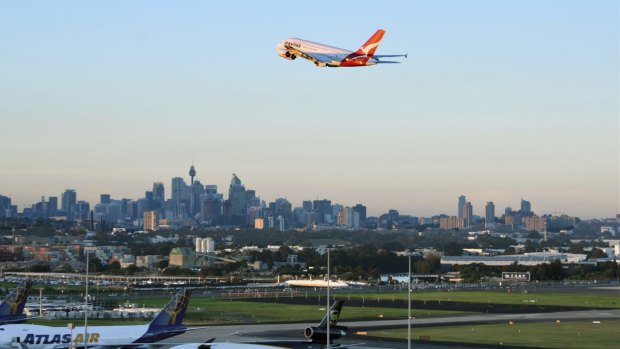
Qantas A380 taking off from Sydney Airport.
"One of the most important events in the early days," Love wrote, "was the arrival of Ross Smith and his crew in their twin-engined Vickers Vimy."
Smith (and his co-pilot, his brother Keith, plus their two mechanics) had won the £10,000 prize in the 1919 Great Air Race from London to Darwin.
The following year, Love flew the first passenger flight from Sydney to Melbourne. It took two days - nine hours of flying time - and the single passenger - John Gibson - paid £200 (the equivalent of about $8500 today).
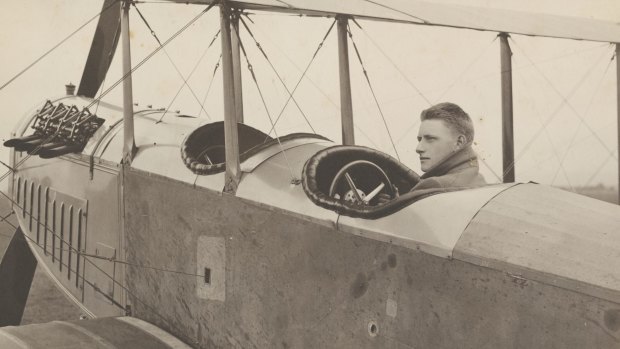
Nigel Love, founder of Sydney Airport and Australian aviation pioneer, circa 1920.Credit: Courtesy of John Love
A century later, the Sydney to Melbourne route is the second busiest air route in the world, with 9 million passengers a year. Seoul to Jeju is Korea the busiest.
According to Deloitte Access Economics' latest figures, Sydney Airport generated 338,500 full-time jobs in 2017 and handled 338,500 aircraft movements ( about 25 per cent of all flights in Australia), worth $38 billion to the Australian economy.
The same company noted Western Sydney International will add an additional $25 billion to the Sydney economy by 2050.
Not a bad return for Love's original investment, taking a punt on a cow pasture.
Neither Love nor Charles Ulm (who was Kingsford Smith's co-pilot in 1928, on the first-ever flight across the Pacific from the US to Australia) had been adequately honoured at the airport until June this year when a building was named after each of them.
In the meantime, Sydney Airport has witnessed just about every revolution in aviation, a host of significant historic events and welcomed countless celebrities, including Queen Elizabeth II, who opened the international terminal in 1970. It has also seen millions of hopeful migrants looking for a brighter future, and helping to create the multi-cultural Australia we enjoy today. And of course, it has seen flights aplenty.
THE WORLD'S 10 OLDEST AIRPORTS (STILL OPERATING)
1. COLLEGE PARK, MARYLAND
"The cradle of aviation" opened in 1909 when Wilbur Wright trained two US Army officers, before air forces had been invented.
2. HAMBURG, GERMANY
Created in 1911, Germany's oldest surviving airport was renovated a decade ago.
3. AUREL VLAICU, BUCHAREST
Also known as Bucharest Baneasa, it officially became an airport in 1912.
4. BREMEN, GERMANY
Established in 1913, just in time to become a military airport in World War II.
5. CIAMPINO, ROME
Opened in 1916, Ciampino was Rome's only airport until 1961. It now serves low-cost airlines.
6. SCHIPHOL, AMSTERDAM
A military airbase in 1916, Schiphol began taking civilian aircraft in 1920. It now offers flights to more than 300 destinations.
7. LE BOURGET, PARIS
Scene of some of aviation's most heroic flights, today Le Bourget is dedicated to business air traffic.
8. KINGSFORD-SMITH, SYDNEY
Australia's first commercial airport.
9. MINNEAPOLIS-ST PAUL, MINNESOTA
Originally named Speedway Field, it opened in 1920 to provide an airmail service and is now a joint civil-military international airport.
10. ALBANY, NEW YORK STATE
The airport welcomed its first passengers in 1928 and now services 2.5 million passengers a year.
AUSTRALIA'S OTHER OLDEST AIRPORTS
1. ESSENDON FIELDS, MELBOURNE
Officially opened in 1921, it was Victoria's main commercial airport until Melbourne Tullamarine was launched in 1970.
2. EAGLE FARM, BRISBANE
Brisbane's first airport opened in 1925 - and was the landing place of the Southern Cross in 1928, when Kingsford Smith and Ulm completed their first trans-Pacific flight. The city's modern airport, opened in 1988, is on neighbouring land.
3. PARAP, DARWIN
Established in 1919 for the finish of the historic England to Australia race race, it was bombed by the Japanese in 1942. The civilian part of Parap was closed in 1946 when the neighbouring military airfield became Darwin International.
4. MAYLANDS, PERTH
Opened in 1924, its finest hour came in 1928 when Kingsford Smith and the Southern Cross completed the first east to west crossing of Australia. Commercial aviation moved to Perth international in 1944.
5. ALBERT PARK, ADELAIDE
SA's first commercial airfield (for mail) opened in 1921. It soon proved inadequate, replaced in 1927 by Parafield Airport before the current Adelaide airport was opened in 1946.
10-POINT TIMELINE
1919
Aviator Nigel Love takes movie photographer Billy Marshall on the first commercial flight above Sydney.
1920
Sydney Airport officially declared an aerodrome. Two months later, Love flies to Melbourne with his first paying customer. It takes nine hours with five stops.
1928
A quarter of Sydney's 1.2 million population turns out to welcome Kingsford Smith and Charles Ulm to Mascot, following their epic trans-Pacific flight in the Southern Cross from California to Brisbane.
1933
Nancy Bird Walton ("Angel of the Outback"),19, becomes the Commonwealth's youngest commercial pilot after training at Kingsford Smith's flying school.
1947
Qantas pioneers its Kangaroo Route from Sydney to London, with six stops (Darwin, Singapore, Calcutta, Karachi, Tripoli),
1959
The first Boeing 707 lands at Sydney, introducing the "jet age" to Australia.
1964
The Beatles (minus an ill Ringo Starr) arrive for their only tour of Australia.
1970
The first "Jumbo Jet" (the wide-bodied Boeing 747 that revolutionised aviation) touches down in Sydney, courtesy of Pam Am. The same year Queen Elizabeth II opens T1 International Terminal.
1972
Boeing's rival, Concorde - still the world's only supersonic commercial plane - arrives in Sydney, courtesy of Air France.
2007
The world's first A380 commercial flight lands at Sydney Airport with Singapore Airlines livery.
TODAY'S SYDNEY AIRPORT IN FIGURES
1.44.4 million: total passengers a year
2.16.7 million: international passengers a year.
3.1.6 million: passengers heading to/from Auckland
4.27.7 million: domestic passengers a year
5.9.3 million: passengers heading to/from Melbourne
6.150,000: number of people in the airport on average day
7.62,150: number of international passengers on Dec 22, 2018, the airport's busiest day since T1 opened in 1970.
8.897: average daily runway movements
9.3962: the length in metres of the main runway
10.30.9: the airport's percentage reduction in carbon emissions since 2010.
Sign up for the Traveller Deals newsletter
Get exclusive travel deals delivered straight to your inbox. Sign up now.